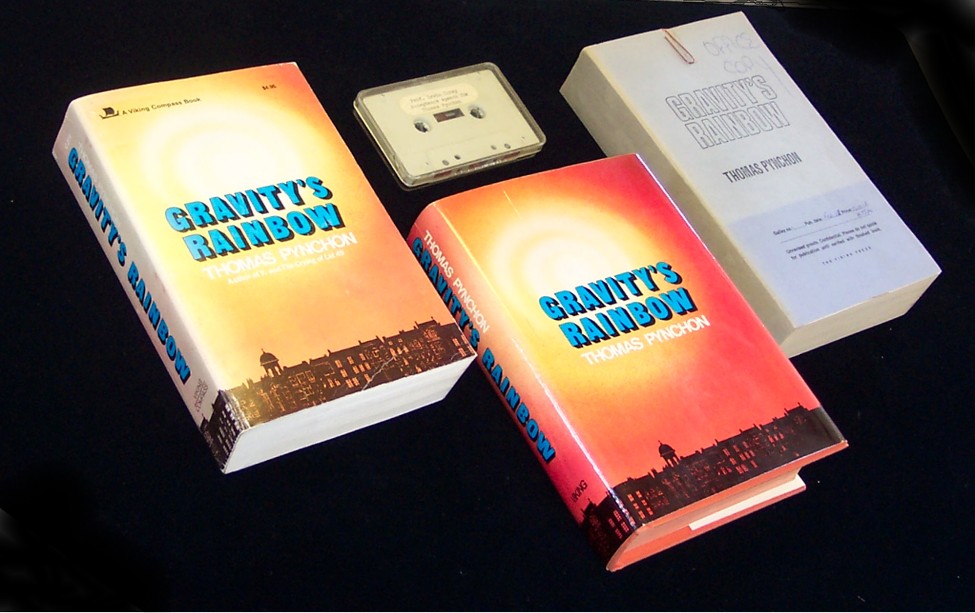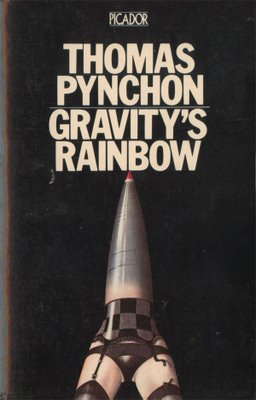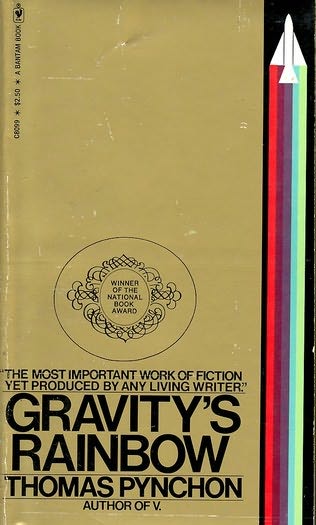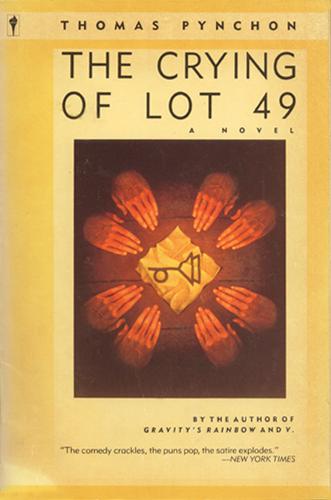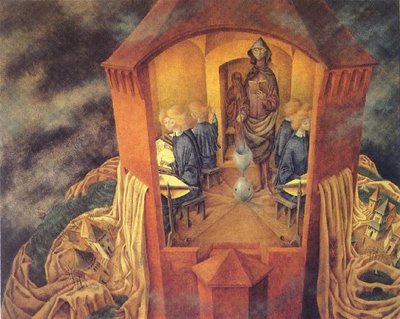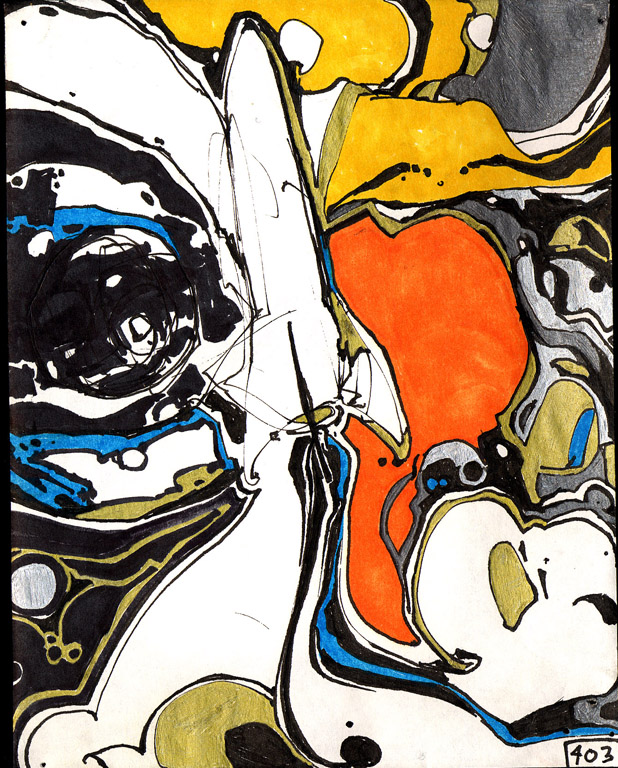This is by far the most challenging book review I’ve ever had to write. I wrote it during my extended stint in Paris (1969-74), after requesting the assignment from an editor at The Village Voice. I was already a big Pynchon fan by then, having already reviewed The Crying of Lot 49 for my college newspaper, The Bard Observer. Years later, I would review both Vineland and Against the Day for the Chicago Reader, Mason & Dixon for In These Times, and Inherent Vice for Slate.
Eventually, after getting assigned to review Gravity’s Rainhow for the Voice in 1973, I received a copy of the bound, uncorrected galleys resembling the one seen below on the right, the marked-up copy of which I still possess today. One significant difference between this version and the published one is the epigraph preceding the fourth and final section, “The Counterforce”. In the published version, which I received shortly before completing my review, this is, “What?” — Richard M. Nixon. In the uncorrected proofs, this is, “She has brought them to her senses, /They have laughed inside her laughter, /Now she rallies her defenses, /For she fears someone will ask her /For eternity — /And she’s so busy being free….” — Joni Mitchell. (Sections 2 and 3 are prefaced by quotations relating to or from King Kong and The Wizard of Oz, respectively, and these films are obliquely alluded to in the following review.)
Over three years later, when I was living in London, I wrote an irate letter in response to what I thought was a philistine reaction to Gravity’s Rainbow by F.S. Schwarzbach in The New Review that was subsequently published. I was then contacted by Edward Mendelson — whom I now believe has written the most perceptive criticism about Pynchon in general and Gravity’s Rainbow in particular — about reprinting my three-paragraph letter along with Schwarzbach’s essay in a collection on Pynchon that he was editing for Prentice-Hall’s Twentieth Century Views series, which he published in 1978. This earlier book review in the Voice, however, has never been reprinted anywhere until now. I reproduce it here intact, complete with the Voice‘s cutesy title/headline and my bum prophecy at the end. — J.R.
One man’s meat is another man’s Poisson
By Jonathan Rosenbaum
_______________________________________________________
GRAVITY’S RAINBOW
A novel by Thomas Pynchon. Viking Press, $15 and $4.95.
————————————————-
“He who leaps into the void owes no explanation to those who watch.”
––Jean-Luc Godard, 1958
There’s a creepy little story called “Don’t Look Behind You,” a paranoid classic of sorts, that scared the wits out of me as a kid. It was the final story in a collection by Fredric Brown, Mostly Murder, and it assured me at the outset that it would be the last story I’d ever read. The narrator is a printer who becomes an accomplished counterfeiter, goes mad, and develops a taste for murdering people at random, always with a knife. He’s decided that he’s become so adept at killing that he can even warn his victims in advance; the story, in fact, is his warning. He’s carefully printed up this story and with his elaborate skills has bound it into only one copy of the book, the one you’re reading; for obvious reasons he’s chosen a collection who last story is called “Don’t Look Behind You,” and wherever you happen to be, he’s somewhere nearby, waiting for you to finish it.
Pynchon’s third novel, set in western Europe 1944-45, ends in a movie theater where all of us — “old fans who’ve always been at the movies (haven’t we?)” — are about to be obliterated by a V-2 rocket traveling faster than the speed of sound, and God help me, I believe that too; it’s too decades since I first encountered that Brown story, and reading Pynchon makes me even more scared.
Paranoia, logically extended, eventually produces genuine agents of destruction, and the horror of Pynchon’s vision is not merely that we’re all victims of obsessive plots, but that we’re all obsessive builders of them. Insofar as we participate in the plot-making of Gravity’s Rainbow — and the multiple ambiguities, confusions, and intrigues essentially require us to, along with the essentially helpless characters — we’re helping to prepare our own annihilation, and worse yet, We’re Getting a Big Bang Out of It. Although this mad and maddening present-tense novel charts the assembly of a rocket immediately before and after the bombing of Hiroshima, we gradually realize that it’s a missile aimed at us, now, inside that movie theatre, appearing overhead like the first evening star. Shall we make a wish? “The screen is a dim page spread before us, white and silent,” and we’re clapping loudly for the show to start.
The appalling whiteness that shines on the next blank page is many things. It is the mixture of all colors, flashing like a rainbow from the rocket’s tail. It is the essence of Weissmann, mastermind of the rocket — a character exported from Pynchon’s first novel, V., re-christened Captain Blicero (his SS code name), and a fair stand-in for the Faustian White Man currently bent on controlling/destroying the planet, with all the ceremonial aplomb of a Dr. Mabuse, or a Cecil B. DeMille. It is the whiteness of semen, coming from the phallus that is the rocket’s human counterpart, orgasm equaling obliteration (le petit mort, goes the French phrase). But above all, it is the whiteness of a nihilist void that envelops us all, which the rocket obligingly fills.
If I insist on using the present tense and first person plural, this is not only because Gravity’s Rainbow concludes with the phrase, “Now everybody—-”. In a sense the entire book is phrased as a dialogue between then/there/them and now/here/us, a fusion of dialectics between Europe and America, history and news, “movies” and “reality,” idea and experience, Frontierland and Tomorrowland.
A friend of Pynchon’s has told me that he has never been to Europe, and biographical blurbs state that he was born in 1937. Like Brown’s narrator, he is an expert counterfeiter, and quite apart from all his loving pastiches — from Raymond Chandler to William Burroughs, Superman to Robert Crumb, and encompassing quite a few of the best and worst “trash” movies of all time — he counterfeits history, geography, science, and countless other disciplines. Thus the extraordinarily realized image of wartime London and environs over the first 100-odd pages is a likely product of long hours at the library, late movies on TV, and a prodigious imagination. But we read on, the gravitational influence of future events speeds the narrative, like the ultimate rocket, toward the target of our contemporary experience, and we increasingly find ourselves caught in an on-flight movie, anachronistically confusing, where today is seen as yesterday, yesterday as today. Like many transatlantic passengers, we are subject to fits of jet lag.
The commanding symbol and structural outline of V. was that initial letter itself, an elusive, multi-faceted expression of a Great Female Principle — relentlessly and fruitlessly pursued by one Herbert Stencil, in search of his identity; blissfully ignored by one Benny Profane; who settles for “yo-yoing” and other local comforts; both of these lines intersecting to form the cusp of the V. Gravity’s Rainbow, a V 2 in more ways than one, inverts the V and rounds it out to form a rocket/phallus/parabola, a Great Male Principle, combining the Stencil and Profane impulses into a single character’s trajectory — a pathway approximating the movement from erection to ejaculation.
Early in the novel we discover that Tyrone Slothrop, an American lieutenant in London, is getting erections in relation to the V-2 bombings; these rockets are falling in a “Poisson distribution,” and an Allied group known as PISCES (Psychological Intelligence Schemes for Expediting Surrender: “whose surrender is not made clear“) enlists him in a series of Pavlovian experiments without letting him know about his unusual talent for duplicating and predicting — or is it provoking? — these hits on a map of his sexual adventures. Duped into a love affair on the Riviera, and slowly discovering that he is being manipulated, he splits for an incognito jaunt across sections of Switzerland and Germany, in search of the truth about his past and penis.
But halfway through the novel, he starts to relent — gradually moves from being a narrative thread (a cog in the plot) to a scattered set of random impulses. We learn that “‘Personal density is directly proportional to temporal bandwidth’….’Temporal bandwidth’ is the width of your present, your now…(and) the narrower your sense of Now, the more tenuous you are. It may even get to where you’re having trouble remembering what you were doing five minutes ago, or even — as Slothrop now — what you’re doing here, at the base of this colossal embankment…”
Thus Slothrop, down the other side of the parabola, is gradually phased out of the novel as visible presence — undergoing a fragmented sort of “Poisson distribution” of his own, fading away into disembodied legend (a trace of grafitti: “Rocketman Was Here“), and opting out of all the Faustian power trips and Oedipal searches that constitute most of Pynchon’s world. Turning away from the King Kong metaphysics of knowledge and power, truth and illusion, sadism and masochism, he follows the yellow brick road toward entropy and dissolution, and when last seen as an integral whole, “after a heavy rain he doesn’t recall,” is watching “a very thick rainbow…a stout rainbow cock driven out of pubic clouds into earth, green wet valleyed Earth, and his chest fills and he stands crying, not a thing in his head, just feeling natural….”
There is no question that once Slothrop starts to disappear, the book becomes harder and harder to read. Jokes tend to stop being funny, the musical-comedy routines (a Pynchon specialty) grow tiresome, habitual flights of invention begin to seem more like compulsive word-chewing, and the twitching of the narrative from one apparently arbitrary center to another often appears itself like dispersions of random energy. Meanwhile, most of the quasi-naturalistic premises that have helped to sustain our interest have all but evaporated, to be replaced by myth and ritualistic mumbo-jumbo, Tarot cards and magic, Germanic science-fiction crossed with homespun visions of hell: hysterical virtuosity becoming virtually hysteria. “If there is something comforting — religious, if you want — about paranoia, there is still also anti-paranoia, where nothing is connected to anything, a condition not many of us can bear for long.”
Yet it seems likely that these exasperations are intentional and even organic to Pynchon’s purposes, for they create a gaping void of chaos and incoherence that only the rocket can fill. And the only ones free from the conversion of confusion into lethal energy are those, like Slothrop, who step out of the narrative line — including those readers who fall by the wayside and don’t finish the book. Everyone else becomes fuel or target for the rocket, which is readied for launching. Like one of Mussolini’s trains, it takes off precisely according to schedule.
But it lands in silence, destroying us faster than its sound can travel, and just as the whiteness of the final empty page is a blend of all colors, the silence is an amalgamation of every sound. One recalls how all the tortured aspirations and cruelty jokes of Nathanael West’s The Day of the Locust become fused into the wail of the hero, imitating a police siren as loudly as he can. Gravity’s Rainbow, which begins with a scream, marshals together every subsequent vibration into a deafening silence, a soundtrack to accompany the blinding whiteness of the movie screen. No warning, and little time for any anticipatory response, save for the “What?” of Richard M. Nixon that heads the novel’s final section, or the cryptically beautiful hymn by Slothrop’s ancestor that all but concludes it.
Pynchon’s theme, style, and vision do not exactly develop from book to book, or even from sentence to sentence: they expand, usually in all directions at once, like an exploding galaxy. Conspiracies become vaster and more intricate, circles expanding inside of expanding circles inside a head, which means the head must grow larger. On my second trip through Gravity’s Rainbow, I made an index to keep up with all the minor characters (they number over 150), bought a German dictionary, Read Rilke and Henry Adams, bugged friends for information about calculus and English history, poked around Shirer and Speer, consulted TV Movies (sorry, Tom, The Return of Jack Slade was released in 1955; Blodgett Waxwing couldn’t have seen it 27 times during World War II), and skimmed through a book on the Tarot: all these things were provisionally useful, and I may have advanced my liberal education a decimal point or two, but I still don’t know who the Kenosha Kid is, and perhaps I never will. No matter: I doubt that anyone could account for everything going on in Gravity’s Rainbow, even Pynchon himself, although I suppose he has an edge on the rest of us.
But despite the bigger canvas of this novel, the greater wealth of detail and complexity, the palette of colors and level of draftsmanship remain essentially the same. A continual war between random and compulsive energies is waged through V., The Crying of Lot 49, and Gravity’s Rainbow, preventing all three from being either complete formed or completely formless, and although the last succeeds somewhat in plotting these impulses on a single parabolic curve, the achievement is never more than partial: much of Slothrop’s “systematic” quest for his identity seems aimless, and a lot of his subsequent scattering seems “systematically” random.
Put another way, Gravity’s Rainbow is at once Pynchon’s most structured book and his most discursive. Beneath the intimidating edifice of his Grand Design creeps the same fungus of local and momentary amusements that ran through the first two novels, and if the 760 pages of this novel were laid end to end, one might well discover that whole yards of it were devoted to marginalia. Some of this is wonderful: the name of a law firm (“Saliteri, Poore, Nash, De Brutus, and Short“), Proverbs for Paranoids sprinkled into the story-line like raisins, a dozen limericks devoted to rocket-sex metaphors, an airborne barrage of custard pies (thrown from balloon to plane by Slothrop at the face of a favorite villain), a riotous improvisation on pinball machines. Other readers may wince at these examples and laugh at the ones I consider sophomoric; the point is that, as Marx remarked, quantity changes quality, and there are times when one longs for the relative compactness of The Crying of Lot 49, where the central metaphors had more of the hard precision of poetry, less of the soft meanderings of run-on prose.
But this is quibbling. Set against the lax spots of Gravity’s Rainbow — barroom brawls and sailor shenanigans that seem to keep running variations on Mr. Roberts, for better and for worse — are sequences that redeem everything. No room to discuss properly a nine-page passage (pages 127 to 136) that may be the most beautiful stretch of sustained lyricism Pynchon has ever given us, with cadenzas like jazz solos based on chord changes by Dickens, a grand rhythmic sweep worthy of Faulkner in his prime, and an emotional rawness that is wholly Pynchon’s own. Nor could I do proper justice here to the magical-surreal appearances of Malcolm X and Mickey Rooney (among others), the death of Webern, the description of a German Disneyland called Zwolfkinder, the tear-jerking romance between Roger and Jessica (in the purest 40s style of Hollywood heartbreak), the comic extravagance of characters like Frau Gnahb (“the terror of the high seas“) and the black-market vessel she steers along the Baltic coast, a page of conversation about the eroticism of suicide, or a mystic western staged in central Asia. The book is a treasure-chest, and a world is still waiting to be found in it.

Predictions are foolish and comparisons risky, yet I can’t help but wonder whether Gravity’s Rainbow will seem as dated in 40 years as Dos Passos’ U.S.A. appears today. Will it be as remote to current preoccupations, but as significant as a time capsule, an accurate rendering of precisely how everyone was freaking out in the late 60s and early 70s? A curious accomplishment to suggest for a novel that purports to be set in the mid-40s, but I think it might. If we are around for another 40 years, I suppose it will have to age: each generation, after all, at least during this century, tends to selfishly regard itself as the last. There have been many dreams of apocalypse before this one, and many others — let us hope — that will follow. But let those living or not living in 2013 worry or not worry about this problem. For now, it is enough to dive into Gravity’s Rainbow and experience the most gifted American novelist under 40, writing at his peak.
—The Village Voice, March 29, 1973


